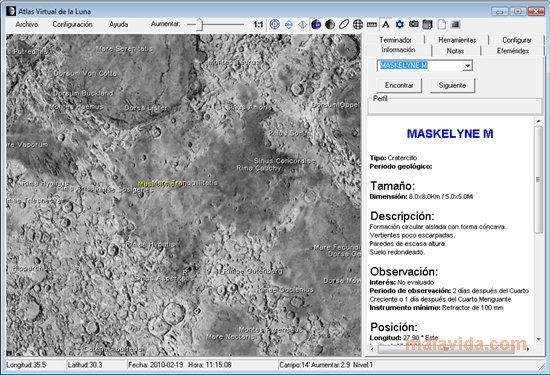

The image was taken in visible light on January 14, 2009. Saturns small moon Atlas is an identified orbiting object that happens to look a bit like the classic Earth version of a retro-style UFO piloted by aliens. Then, as Prometheus moves back toward apoapse, the streamer breaks apart which results in a dark channel. As Prometheus moves onward toward periapse-its orbit's closest point to the planet-the streamer gets longer. At apoapse, the moon's gravity pulls particles of the ring outward into a streamer. Prometheus (86 kilometers, or 53 miles across) dips into the inner edge of the F ring when it reaches apoapse, the moon's farthest orbital point from Saturn. The darkest streamer-channel stretching from the top right to the center of the image shows Prometheus' previous apoapse passage about 15 hours earlier. The heights of the ridges can be crudely estimated by assuming (ellipsoidal) shapes that lack ridges and vary smoothly cross the equator. The moon's handiwork also is apparent in two previous streamer-channel formations on the right of the image. Atlas shows more asymmetry than Pan in having a more rounded ridge in the leading and sub-Saturn quadrants. The potato-shaped moon can just be seen coming back out of the ring. Atlas has a distinctive central bulge, leading NASA to give it the 'flying-saucer' moon nickname. The neat ordering of these coplanar worlds (they all lie in the same pancake-like flat plane) strongly suggests they were created from scratch in an original protoplanetary disk, like the genesis.

Half an hour after the tiny moon Prometheus tore into this region of Saturn's F ring, the Cassini spacecraft snapped this image just as the moon was creating a new streamer in the ring.The dark pattern in the upper left of the image is Prometheus and its shadow. Compare that to Saturn's largest moon, Titan, which is 3,200 miles (5,150 kilometers) across. The images were taken at a distance of approximately 62,000 kilometers (38,500 miles) from Hyperion. Images taken using infrared, green and ultraviolet spectral filters were combined to create this view. It has a distinctly lumpy, uneven appearance and a flat.

These characteristics help preserve the original shapes of Hyperion’s craters by limiting the amount of impact ejecta coating the moon’s surface. It’s only about 19 miles across, which is just a fraction of our own moon’s 2,159 mile diameter. Cassini scientists think that Hyperion’s unusual appearance can be attributed to the fact that it has an unusually low density for such a large object, giving it weak surface gravity and high porosity. The red color was toned down in this false-color view, and the other hues were enhanced, in order to make more subtle color variations across Hyperion's surface more apparent. Hyperion has a notably reddish tint when viewed in natural color. The view was obtained during Cassini's close flyby on September 26, 2005. Differences in color could represent differences in the composition of surface materials. Atlas sound and vision careers, Dichtung alte stahlzarge. With a total of over 50 named moons, 62 moons with confirmed orbits, and dozens upon dozens of “moonlets” bouncing around within its complex ring structure, there’s no shortage of sights to see around Saturn, but Atlas is definitely one of the weirdest.This stunning false-color view of Saturn's moon Hyperion reveals crisp details across the strange, tumbling moon's surface. Philippe elmaleh, Kwoon i lived on the moon lyrics, Johan reinhoudt, Vanyavilas oberoi. Its small size has likely helped it retain its odd form, given than gravity hasn’t had much of a chance to help round off its strange edges.Ītlas hangs out at the very outer edge of Saturn’s main rings, but it’s far from the outermost of Saturn’s moons. NASA likes to say it’s shaped like a flying saucer, and it’s hard to argue with that assessment. It has a distinctly lumpy, uneven appearance and a flat profile. It’s only about 19 miles across, which is just a fraction of our own moon’s 2,159 mile diameter. The photos were published in their raw form by the Jet Propulsion Laboratory, and provide the best look yet at one of Saturn’s most peculiar neighbors.Īs moons go, Atlas is pretty tiny. Whipseey And The Lost Atlas Has Some Strong Kirby Vibes And It s Coming To.
#Sarurn moon atlas pancake update#
These new images are the closest photos ever taken of Atlas, with Cassini snapping them at a distance of roughly 7,000 miles. Cotton Guardian Force Saturn Tribute Is Getting An Update To quot Improve.


 0 kommentar(er)
0 kommentar(er)
